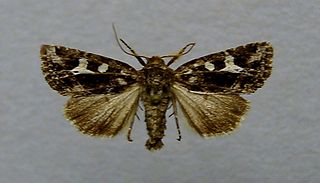
Agrotis is a genus of moths of the family Noctuidae. The genus was erected by Ferdinand Ochsenheimer in 1816. A number of the species of this genus are extinct.

Discophlebia catocalina, the yellow-tailed stub moth is an Australian moth species found in the south-eastern quartile of Australia. It is classified within the Oenosandridae moth family in the Noctuoidea Superfamily, the largest superfamily of the Order Lepidoptera. It is visually recognised by its characteristic pointed yellow tail and is a medium-sized moth species with a wingspan range of 40mm-60mm depending on gender. Discophlebia Catocalina have evolved to feed on various species of eucalypt.

Discophlebia lucasii, or Lucas' stub moth, is a moth of the family Oenosandridae first described by Rudolph Rosenstock in 1885. It is found in the south-east quarter of Australia.
Araeomorpha is a genus of moths of the family Crambidae.

Metasia is a genus of moths of the family Crambidae. They are found mainly in Europe and Australia, but also in Africa, Asia, North America, and Pacific islands.

Celaena is a genus of moths of the family Noctuidae.

Euproctis is a genus of tussock moths in the family Erebidae described by Jacob Hübner in 1819. Species are cosmopolitan, widespread throughout Palearctic, African, Oriental and Australian regions. Molecular phylogenetic studies indicate that the genus as presently understood comprises a large number of unrelated lineages, only a few of which have names, and is therefore in serious need of revision.

Discophlebia is a genus of moths of the family Oenosandridae first described by Rudolf Felder in 1874.

Niguza eucesta is a species of moth of the family Erebidae first described by Alfred Jefferis Turner in 1903. It is found in Australia in New South Wales, Queensland and the Northern Territory.
Discophlebia lipauges is a moth of the family Oenosandridae first described by Alfred Jefferis Turner in 1917. It is found in Australia.

Celaena haworthii, or Haworth's minor, is a moth of the family Noctuidae. The species was first described by John Curtis in 1829. It is found from the British Isles and France through northern Europe including Scandinavia, east to the Urals and across the Palearctic to Siberia and up to the Pacific Ocean.

Alapadna pauropis, the variable spot-wing, is a species of moth of the family Noctuidae first described by Alfred Jefferis Turner in 1902. It is found in the Australian states of Queensland, New South Wales, Victoria and Tasmania.

Miscera is a genus of moths in the family Brachodidae.

Procometis is a genus of moths in the family Autostichidae.

Helotropha reniformis, the reniform celaena, is a species of moth in the family Noctuidae. The species was described by Augustus Radcliffe Grote in 1874. It is found in North America.
This page is based on this
Wikipedia article Text is available under the
CC BY-SA 4.0 license; additional terms may apply.
Images, videos and audio are available under their respective licenses.










